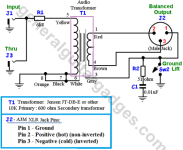owlexifry
Well-known member
i keep reading claims that you can't use a DI box as a reamp box.
my understanding is that they both do they same thing, but in reverse, so are they really that exclusively different? there seems to be all sorts of differing expert opinions on the matter... (incl. some claims of folks using DI boxes in reverse to perform reamping duties)
i've been sitting on a JT-DB-E transformer for some time - with plans to build a DI box (with the schematic below) - but I'm wondering if i could use this DI box as a reamp box, or not..
I'm suspecting the primary:secondary impedance specifications may have a big part in this consideration...

(from http://www.generalguitargadgets.com/pdf/ggg_dbox_pass2_sc.pdf)
my understanding is that they both do they same thing, but in reverse, so are they really that exclusively different? there seems to be all sorts of differing expert opinions on the matter... (incl. some claims of folks using DI boxes in reverse to perform reamping duties)
i've been sitting on a JT-DB-E transformer for some time - with plans to build a DI box (with the schematic below) - but I'm wondering if i could use this DI box as a reamp box, or not..
I'm suspecting the primary:secondary impedance specifications may have a big part in this consideration...

(from http://www.generalguitargadgets.com/pdf/ggg_dbox_pass2_sc.pdf)

